Distribution of Soil Organic Carbon Density Fractions in Aggregates as Influenced by Salts and Microbial Community
Abstract
:1. Introduction
2. Materials and Methods
2.1. The Study Site
2.2. Soil Collection and Water-Stable Aggregate Determination
2.3. SOC Density Fractions in Different Water-Stable Aggregate Sizes
2.4. Soil Salt and Ion Measurements in Different Water-Stable Aggregate Sizes
2.5. DNA Extraction and Sequencing for Different Soil Aggregate Sizes
2.6. Statistical Analysis
3. Results
3.1. Soil Ions Distribution with Aggregates
3.2. Microbial Communities in Different Soil Aggregate Sizes
3.3. Soil Aggregate-Associated SOC Density Fraction Distribution
3.4. Relationships between Soil Salt, Microbes within Aggregates, and Carbon Content
4. Discussion
4.1. Salt Ion Distribution in Aggregate and Their Effect on Microbial Distribution
4.2. Carbon Density Fraction Distribution in Aggregates in Response to Microbes
5. Conclusions
Supplementary Materials
Author Contributions
Funding
Data Availability Statement
Acknowledgments
Conflicts of Interest
References
- Wu, R.; Sun, H.; Xue, J.; Yan, D.; Liu, Y.; Gui, D.; Wang, X.; Yang, J. Acceleration of soil salinity accumulation and soil degradation due to greenhouse cultivation: A survey of farmers’ practices in China. Environ. Monit. Assess. 2020, 192, 399. [Google Scholar] [CrossRef] [PubMed]
- Zhang, F.; Li, S.; Xiao, D.; Zhao, J.; Wang, R.; Guo, X.; Wang, S. Progress in Pest Management by Natural Enemies in Greenhouse Vegetables in China. Sci. Agric. Sin. 2015, 48, 3463–3476. [Google Scholar]
- Bonachela, S.; Dolores Fernandez, M.; Javier Cabrera, F.; Rosa Granados, M. Soil spatio-temporal distribution of water, salts and nutrients in greenhouse, drip-irrigated tomato crops using lysimetry and dielectric methods. Agric. Water Manag. 2018, 203, 151–161. [Google Scholar] [CrossRef]
- Zhang, L.; Song, L.; Wang, B.; Shao, H.; Zhang, L.; Qin, X. Co-effects of salinity and moisture on CO2 and N2O emissions of laboratory-incubated salt-affected soils from different vegetation types. Geoderma 2018, 332, 109–120. [Google Scholar] [CrossRef]
- Reddy, N.; Crohn, D.M. Quantifying the effects of active and cured greenwaste and dairy manure application and temperature on carbon dioxide, nitrous oxide, and dinitrogen emissions from an extreme saline-sodic soil. Catena 2019, 173, 83–92. [Google Scholar] [CrossRef]
- Wong, V.N.L.; Greene, R.S.B.; Dalal, R.C.; Murphy, B.W. Soil carbon dynamics in saline and sodic soils: A review. Soil Use Manag. 2010, 26, 2–11. [Google Scholar] [CrossRef]
- Yudina, A.; Kuzyakov, Y. Dual nature of soil structure: The unity of aggregates and pores. Geoderma 2023, 434, 116478. [Google Scholar] [CrossRef]
- Six, J.; Elliott, E.T.; Paustian, K.; Doran, J.W. Aggregation and soil organic matter accumulation in cultivated and native grassland soils. Soil Sci. Soc. Am. J. 1998, 62, 1367–1377. [Google Scholar] [CrossRef]
- Yin, Y.; Liang, C.-H.; Pei, Z.-J. Effect of greenhouse soil management on soil aggregation and organic matter in northeast China. Catena 2015, 133, 412–419. [Google Scholar] [CrossRef]
- Thapa, R.; Chatterjee, A.; Wick, A.; Butcher, K. Carbon Dioxide and Nitrous Oxide Emissions from Naturally Occurring Sulfate-Based Saline Soils at Different Moisture Contents. Pedosphere 2017, 27, 868–876. [Google Scholar] [CrossRef]
- Six, J.; Elliott, E.T.; Paustian, K. Soil macroaggregate turnover and microaggregate formation: A mechanism for C sequestration under no-tillage agriculture. Soil Biol. Biochem. 2000, 32, 2099–2103. [Google Scholar] [CrossRef]
- Feng, H.; Wang, S.; Gao, Z.; Pan, H.; Zhuge, Y.; Ren, X.; Hu, S.; Li, C. Aggregate stability and organic carbon stock under different land uses integrally regulated by binding agents and chemical properties in saline-sodic soils. Land Degrad. Dev. 2021, 32, 4151–4161. [Google Scholar] [CrossRef]
- FAO. World Soil Resources: An Explanatory Note on the FAO World Soil Resources Map at 1:25,000,000 Scale; World Soil Resources Report 66; Food Agricultural Organization: Rome, Italy, 1991. [Google Scholar]
- Rengasamy, P. World salinization with emphasis on Australia. J. Exp. Bot. 2006, 57, 1017–1023. [Google Scholar] [CrossRef] [PubMed]
- Kloster, N.; Avena, M. Interaction of humic acids with soil minerals: Adsorption and surface aggregation induced by Ca2+. Environ. Chem. 2015, 12, 731–738. [Google Scholar] [CrossRef]
- Cao, Q.; Wei, X.; Wu, C.; Sun, W.; Tang, Y.; Gu, X. Simulation Study on Effects of Salt Accumulation on Electrochemical Properties and Water-stable Aggregates in Greenhouse Soil. Bull. Soil Water Conserv. 2016, 36, 164–168. [Google Scholar]
- Rath, K.M.; Rousk, J. Salt effects on the soil microbial decomposer community and their role in organic carbon cycling: A review. Soil Biol. Biochem. 2015, 81, 108–123. [Google Scholar] [CrossRef]
- Gupta, V.V.S.R.; Germida, J.J. Soil aggregation: Influence on microbial biomass and implications for biological processes. Soil Biol. Biochem. 2015, 80, A3–A9. [Google Scholar] [CrossRef]
- Rousk, J.; Baath, E.; Brookes, P.C.; Lauber, C.L.; Lozupone, C.; Caporaso, J.G.; Knight, R.; Fierer, N. Soil bacterial and fungal communities across a pH gradient in an arable soil. ISME J. 2010, 4, 1340–1351. [Google Scholar] [CrossRef]
- Xu, P.; Zhu, J.; Wang, H.; Shi, L.; Zhuang, Y.; Fu, Q.; Chen, J.; Hu, H.; Huang, Q. Regulation of soil aggregate size under different fertilizations on dissolved organic matter, cellobiose hydrolyzing microbial community and their roles in organic matter mineralization. Sci. Total Environ. 2021, 755, 142595. [Google Scholar] [CrossRef]
- Trivedi, P.; Delgado-Baquerizo, M.; Jeffries, T.C.; Trivedi, C.; Anderson, I.C.; Lai, K.; McNee, M.; Flower, K.; Singh, B.P.; Minkey, D.; et al. Soil aggregation and associated microbial communities modify the impact of agricultural management on carbon content. Environ. Microbiol. 2017, 19, 3070–3086. [Google Scholar] [CrossRef]
- Haj-Amor, Z.; Araya, T.; Kim, D.-G.; Bouri, S.; Lee, J.; Ghilou, W.; Yang, Y.; Kang, H.; Jhariya, M.K.; Banerjee, A.; et al. Soil salinity and its associated effects on soil microorganisms, greenhouse gas emissions, crop yield, biodiversity and desertification: A review. Sci. Total Environ. 2022, 843, 156946. [Google Scholar] [CrossRef]
- Ju, Z.; Du, Z.; Guo, K.; Liu, X. Irrigation with freezing saline water for 6years alters salt ion distribution within soil aggregates. J. Soils Sediments 2019, 19, 97–105. [Google Scholar] [CrossRef]
- Yu, H.; Li, T.; Zhou, J. Salt accumulation, translocation and ion composition in greenhouse soil profiles. Plant Nutr. Fertil. Sci. 2007, 13, 642–650. [Google Scholar]
- He, Y.; DeSutter, T.M.; Clay, D.E. Dispersion of Pure Clay Minerals as Influenced by Calcium/Magnesium Ratios, Sodium Adsorption Ratio, and Electrical Conductivity. Soil Sci. Soc. Am. J. 2013, 77, 2014–2019. [Google Scholar] [CrossRef]
- Marchuk, S.; Marchuk, A. Effect of applied potassium concentration on clay dispersion, hydraulic conductivity, pore structure and mineralogy of two contrasting Australian soils. Soil Tillage Res. 2018, 182, 35–44. [Google Scholar] [CrossRef]
- Yang, H.; Chen, S.; Feng, Z.; Deng, Z.; Li, Z.; Wang, S. Combined effects of soil microbes and organic matter on aggregate formation in saline-alkali soil. J. Agro-Environ. Sci. 2017, 36, 2080–2085. [Google Scholar]
- Li, Y.; Shen, C.; Wang, Y.; Xu, L.; Zhao, Y.; Yi, S.; Zuo, W.; Yao, R.; Zhang, X.; Gu, C.; et al. Alleviated environmental constraints and restructured fungal microbiome facilitate aggregate formation and stabilization in coastal mudflat saline soil amended by sewage sludge. Land Degrad. Dev. 2023, 34, 3064–3075. [Google Scholar] [CrossRef]
- Liu, M.; Wang, C.; Wang, F.; Xie, Y. Vermicompost and humic fertilizer improve coastal saline soil by regulating soil aggregates and the bacterial community. Arch. Agron. Soil Sci. 2019, 65, 281–293. [Google Scholar] [CrossRef]
- Coban, O.; De Deyn, G.B.; van der Ploeg, M. Soil microbiota as game-changers in restoration of degraded lands. Science 2022, 375, 990. [Google Scholar] [CrossRef]
- Puget, P.; Chenu, C.; Balesdent, J. Dynamics of soil organic matter associated with particle-size fractions of water-stable aggregates. Eur. J. Soil Sci. 2000, 51, 595–605. [Google Scholar] [CrossRef]
- Yamashita, T.; Flessa, H.; John, B.; Helfrich, M.; Ludwig, B. Organic matter in density fractions of water-stable aggregates in silty soils: Effect of land use. Soil Biol. Biochem. 2006, 38, 3222–3234. [Google Scholar] [CrossRef]
- Bill, M.; Chidamba, L.; Gokul, J.K.; Labuschagne, N.; Korsten, L. Bacterial community dynamics and functional profiling of soils from conventional and organic cropping systems. Appl. Soil Ecol. 2021, 157, 103734. [Google Scholar] [CrossRef]
- Lu, X.; Lu, X.; Liao, Y. Effect of Tillage Treatment on the Diversity of Soil Arbuscular Mycorrhizal Fungal and Soil Aggregate-Associated Carbon Content. Front. Microbiol. 2018, 9, 2986. [Google Scholar] [CrossRef] [PubMed]
- Cao, H.; Xie, J.; Hong, J. Variation characteristics of organic carbon fractions within macroaggregates under long-term different fertilization regimes in the reclaimed soil. J. China Coal Soc. 2021, 46, 1046–1055. [Google Scholar]
- Dorodnikov, M.; Kuzyakov, Y.; Fangmeier, A.; Wiesenberg, G.L.B. C and N in soil organic matter density fractions under elevated atmospheric CO2: Turnover vs. stabilization. Soil Biol. Biochem. 2011, 43, 579–589. [Google Scholar] [CrossRef]
- Wang, G.; Jia, H.; Zhuang, J.; Glatzel, S.; Bennett, J.M.; Zhu, Y. Growing-season soil microbial respiration response to long-term no tillage and spring ridge tillage. Int. J. Agric. Biol. Eng. 2020, 13, 143–150. [Google Scholar] [CrossRef]
- Zhang, J.; Wang, P.; Tian, H.; Xiao, Q.; Jiang, H. Pyrosequencing-based assessment of soil microbial community structure and analysis of soil properties with vegetable planted at different years under greenhouse conditions. Soil Tillage Res. 2019, 187, 1–10. [Google Scholar] [CrossRef]
- Yin, Y.; Liang, C.H.; Xi, F.M.; Du, L.Y.; Li, J.Y.; Liu, L. Micro-Aggregate Stability in Greenhouse Management System in Northeast China. Eurasian Soil Sci. 2021, 54, 1350–1358. [Google Scholar] [CrossRef]
- Rowley, M.C.; Grand, S.; Verrecchia, E.P. Calcium-mediated stabilisation of soil organic carbon. Biogeochemistry 2018, 137, 27–49. [Google Scholar] [CrossRef]
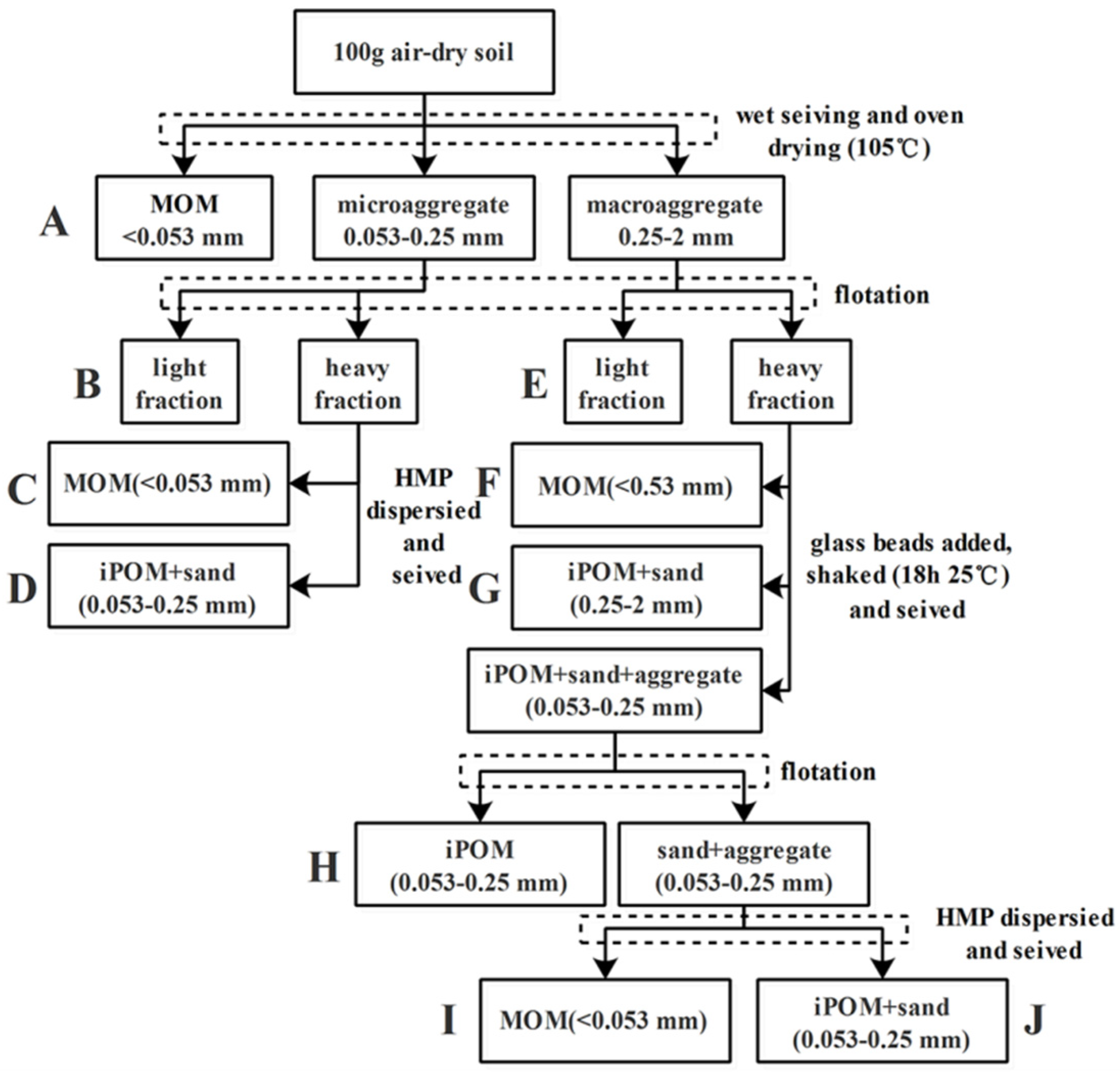
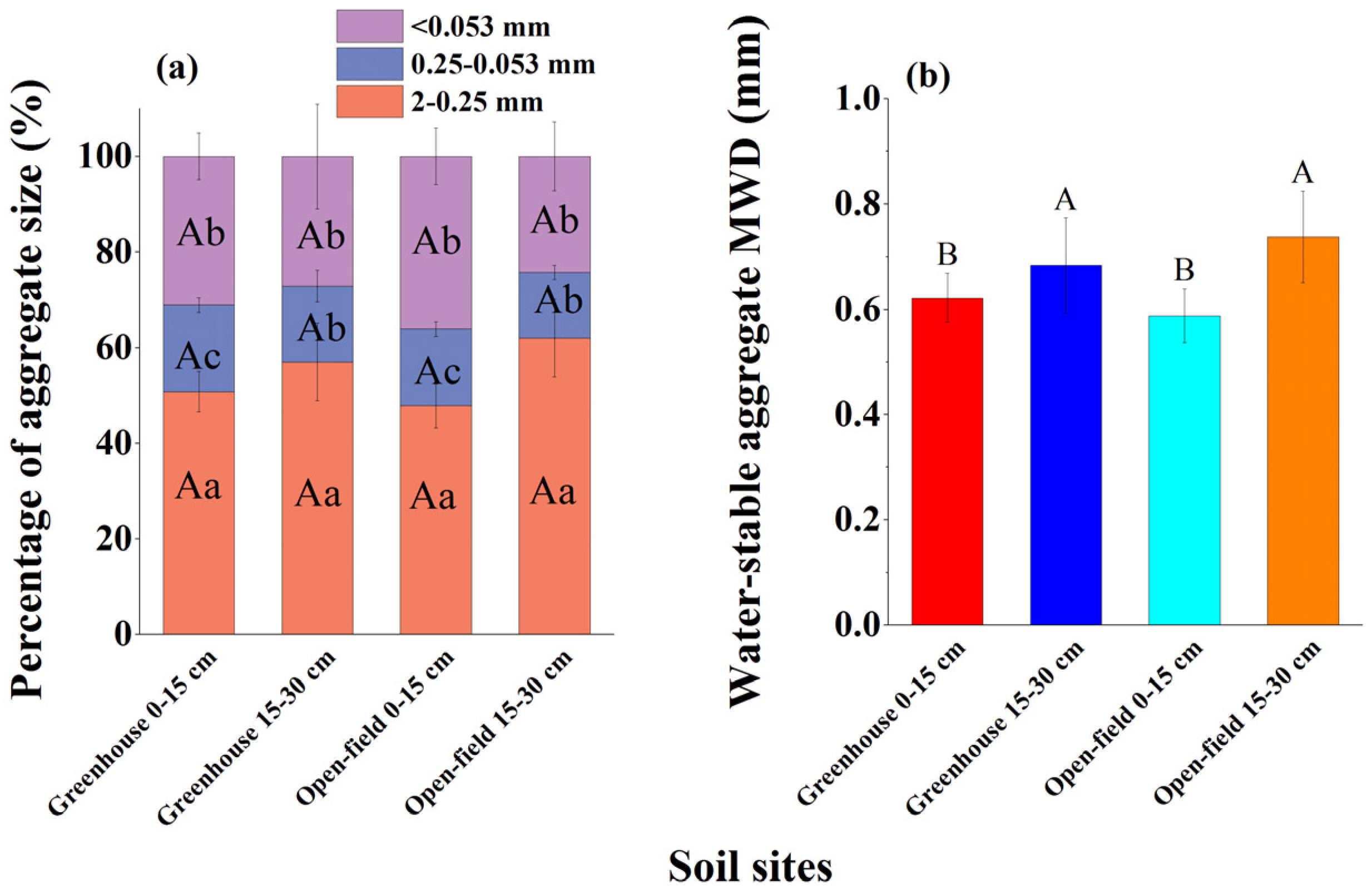
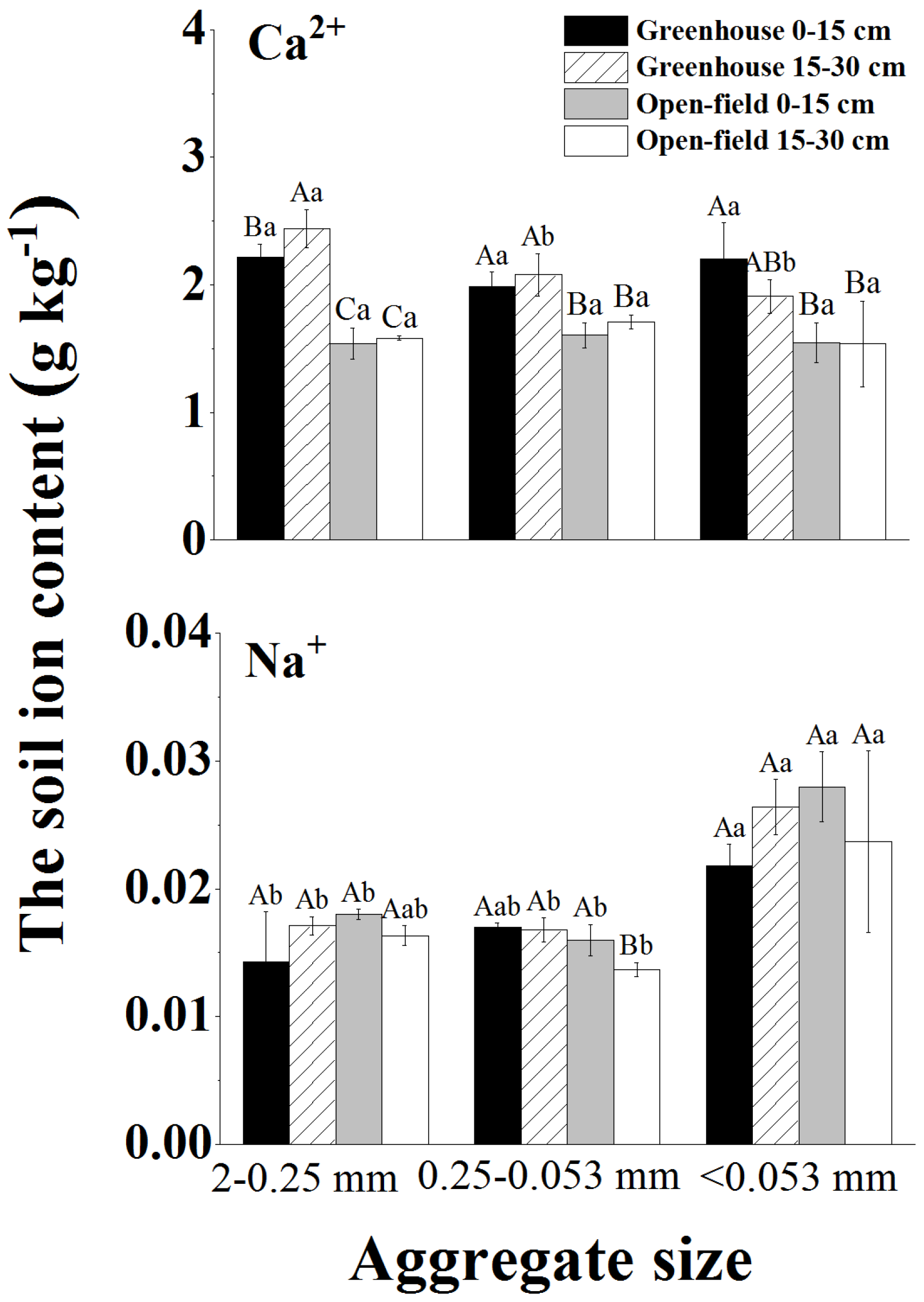
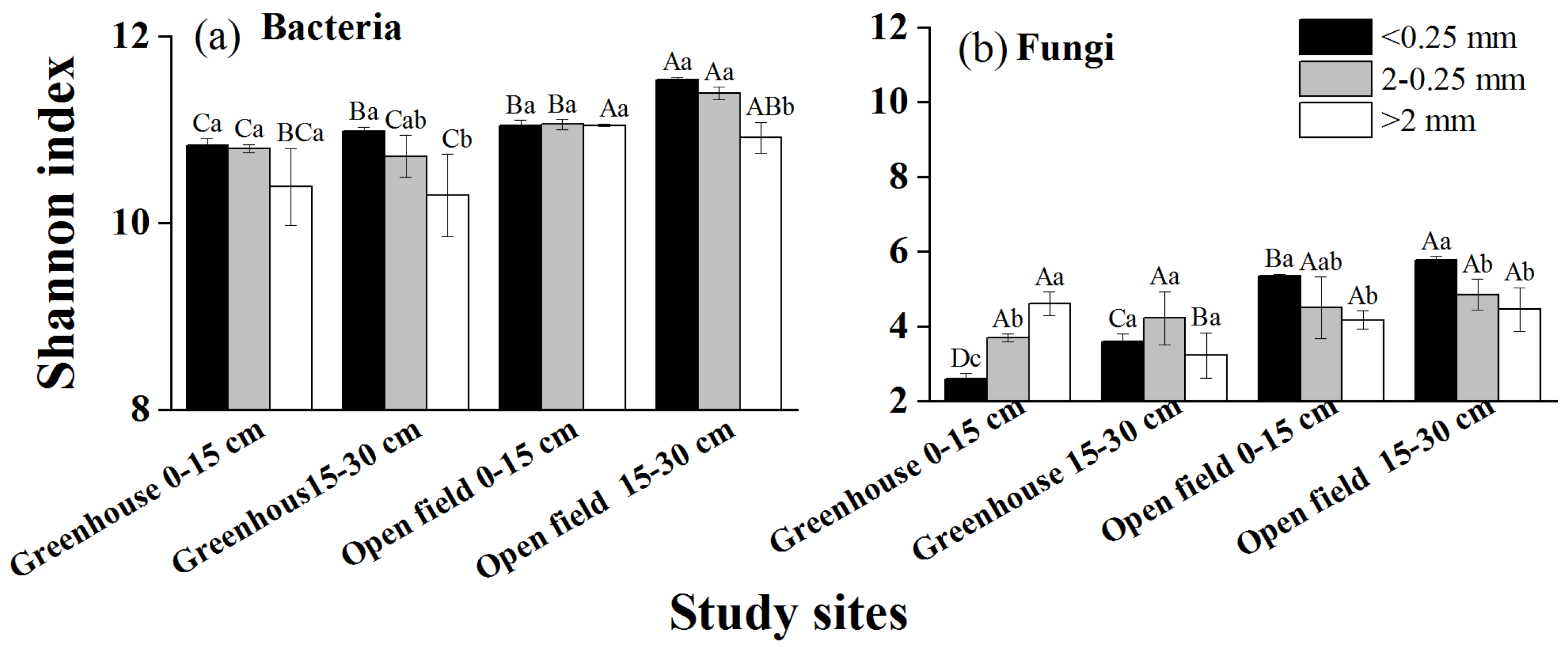

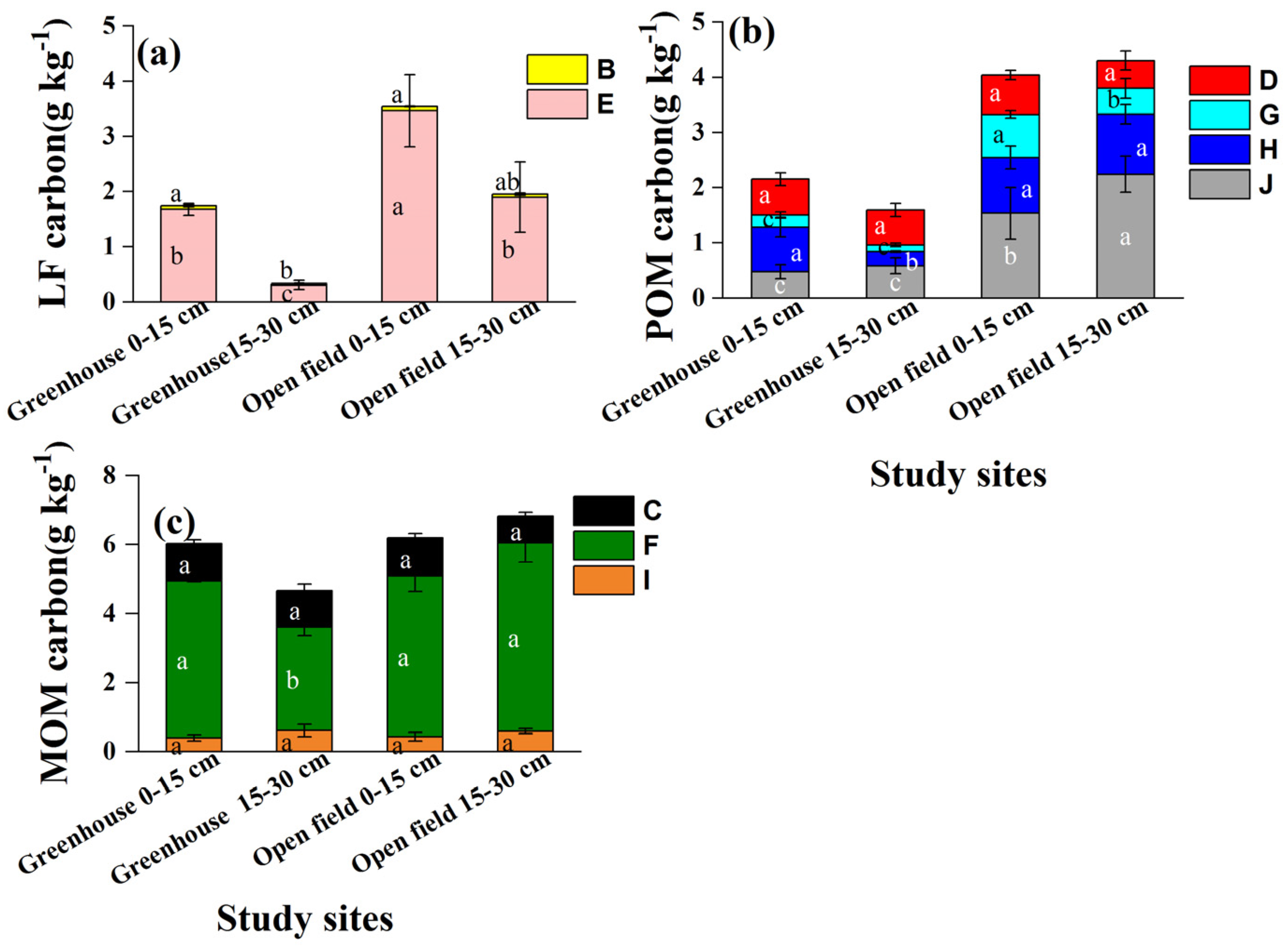
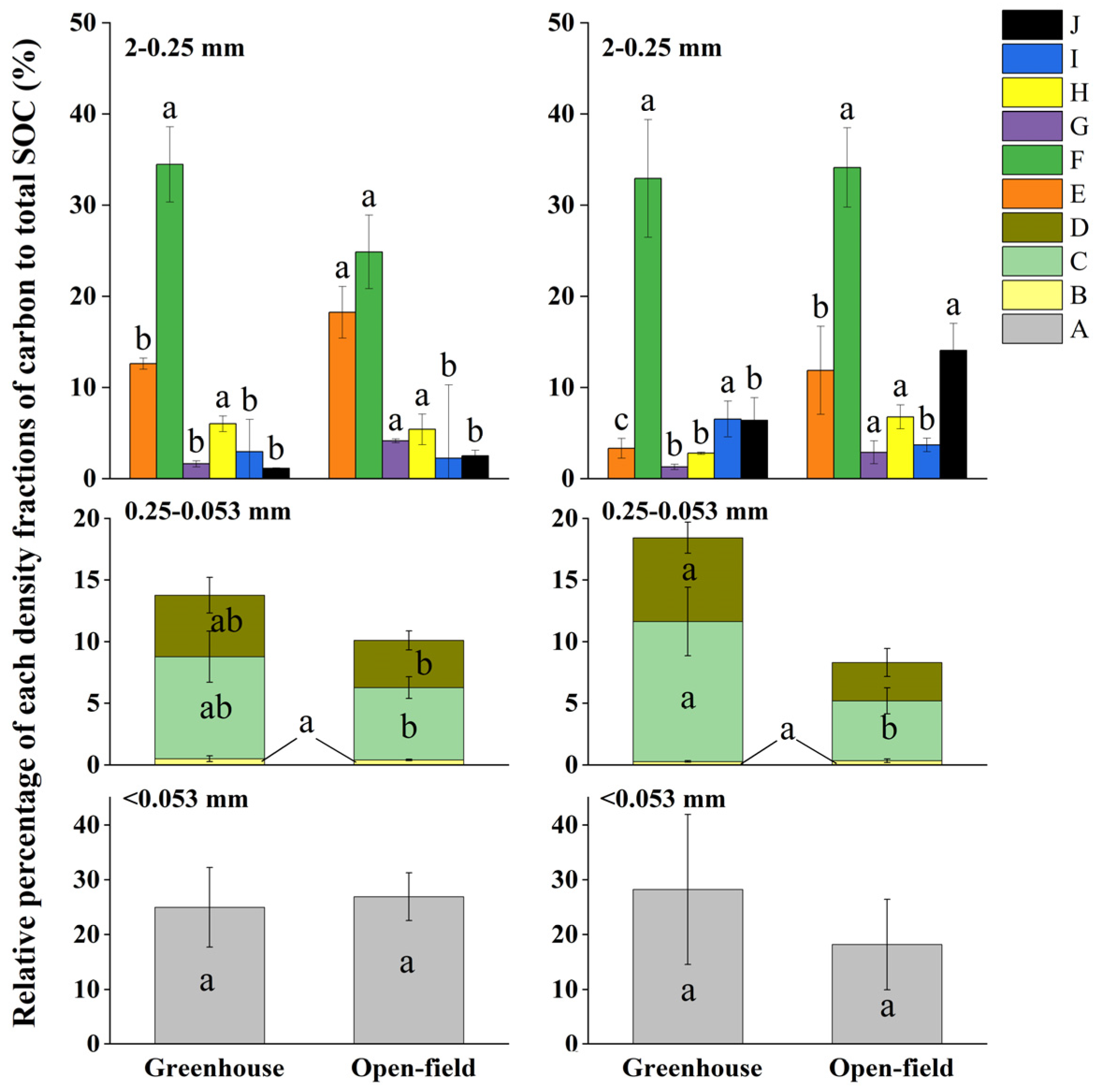

| Site | Depth | ρb | SOC | EC | pH | Sand | Silt | Clay |
|---|---|---|---|---|---|---|---|---|
| cm | g cm−3 | g kg−1 | μS cm−1 | % | ||||
| Greenhouse | 0~15 | 1.34 b | 10.02 a | 2487 a | 5.28 b | 15.16 a | 63.29 a | 21.54 a |
| 15~30 | 1.52 a | 5.26 b | 1011 b | 5.63 b | 13.86 a | 63.28 a | 22.86 a | |
| Open-field | 0~15 | 1.35 b | 10.91 a | 580 c | 6.51 a | 13.72 a | 63.34 a | 22.94 a |
| 15~30 | 1.63 a | 6.06 b | 337 c | 6.32 a | 13.98 a | 64.49 a | 21.53 a | |
| 0.25–0.053 mm | 2–0.25 Ca | 0.25–0.053 Ca | 0.053Ca | 2–0.25 Ca/Na | Fungal Shannon | <0.25 Ascomycota | <0.25 Basidiomycota | |
|---|---|---|---|---|---|---|---|---|
| 0.25–0.053 mm | 1 | −0.86 | −0.92 | −0.84 | −0.94 | 0.65 | −0.87 | 0.97 * |
| 2–0.25 Ca | −0.86 | 1 | 0.99 * | 0.83 | 0.93 | −0.90 | 0.85 | −0.95 * |
| 0.25–0.053 Ca | −0.92 | 0.99 * | 1 | 0.83 | 0.95 | −0.83 | 0.84 | −0.88 |
| 0.053 Ca | −0.84 | 0.83 | 0.83 | 1 | 0.96 * | −0.87 | 0.96 * | −0.90 |
| 2–0.25 Ca/Na | −0.94 | 0.93 | 0.95 | + | 1 | −0.86 | 0.99 * | −0.98 * |
| Fungal Shannon | 0.65 | −0.90 | −0.83 | −0.87 | −0.86 | 1 | −0.93 | 0.81 |
| <0.25 Ascomycota | −0.87 | 0.85 | 0.84 | 0.96 * | 0.99 * | −0.93 | 1 | −0.96 * |
| <0.25 Basidiomycota | 0.97 * | −0.95 * | −0.88 | −0.90 | −0.98 * | 0.81 | −0.96 * | 1 |
| A-type SOC | 0.92 | −0.92 | −0.96 | −0.67 | −0.85 | 0.65 | −0.81 | 0.93 |
| B-type SOC | 0.52 | −0.31 | −0.34 | −0.79 | −0.62 | 0.46 | −0.60 | 0.49 |
| C-type SOC | 0.96 * | −0.72 | −0.82 | −0.67 | −0.81 | 0.42 | −0.71 | 0.87 |
| D-type SOC | 0.67 | −0.22 | −0.37 | −0.25 | −0.37 | −0.14 | −0.22 | 0.46 |
| E-type SOC | −0.53 | 0.22 | 0.28 | 0.70 | 0.55 | −0.30 | 0.50 | −0.44 |
| F-type SOC | 0.55 | −0.82 | −0.79 | −0.36 | −0.57 | 0.62 | −0.59 | 0.67 |
| G-type SOC | 0.98 * | −0.92 | −0.97 * | −0.79 | −0.93 | 0.69 | −0.87 | 0.98 * |
| H-type SOC | 0.39 | −0.46 | −0.50 | 0.07 | −0.21 | 0.08 | −0.17 | 0.38 |
| I-type SOC | 0.78 | −0.77 | −0.82 | −0.40 | −0.64 | 0.41 | −0.58 | 0.77 |
| J-type SOC | 0.77 | −0.96 * | −0.82 | −0.90 | −0.93 | 0.98 * | −0.98 * | 0.90 |
Disclaimer/Publisher’s Note: The statements, opinions and data contained in all publications are solely those of the individual author(s) and contributor(s) and not of MDPI and/or the editor(s). MDPI and/or the editor(s) disclaim responsibility for any injury to people or property resulting from any ideas, methods, instructions or products referred to in the content. |
© 2023 by the authors. Licensee MDPI, Basel, Switzerland. This article is an open access article distributed under the terms and conditions of the Creative Commons Attribution (CC BY) license (https://creativecommons.org/licenses/by/4.0/).
Share and Cite
Yang, W.; Song, X.; He, Y.; Chen, B.; Zhou, Y.; Chen, J. Distribution of Soil Organic Carbon Density Fractions in Aggregates as Influenced by Salts and Microbial Community. Land 2023, 12, 2024. https://doi.org/10.3390/land12112024
Yang W, Song X, He Y, Chen B, Zhou Y, Chen J. Distribution of Soil Organic Carbon Density Fractions in Aggregates as Influenced by Salts and Microbial Community. Land. 2023; 12(11):2024. https://doi.org/10.3390/land12112024
Chicago/Turabian StyleYang, Wei, Xingsheng Song, Yangbo He, Bige Chen, Ying Zhou, and Jiazhou Chen. 2023. "Distribution of Soil Organic Carbon Density Fractions in Aggregates as Influenced by Salts and Microbial Community" Land 12, no. 11: 2024. https://doi.org/10.3390/land12112024
APA StyleYang, W., Song, X., He, Y., Chen, B., Zhou, Y., & Chen, J. (2023). Distribution of Soil Organic Carbon Density Fractions in Aggregates as Influenced by Salts and Microbial Community. Land, 12(11), 2024. https://doi.org/10.3390/land12112024






